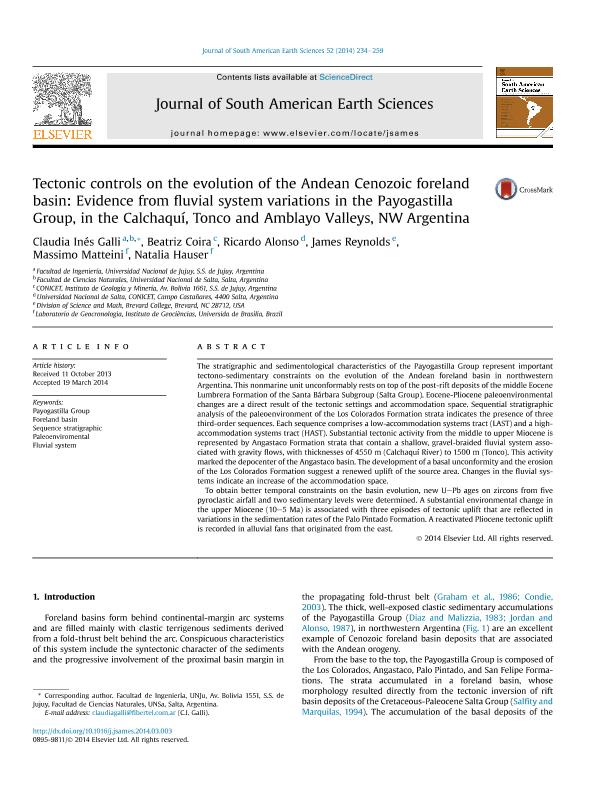Artículo
Tectonic controls on the evolution of the Andean Cenozoic foreland basin: Evidence from fluvial system variations in the Payogastilla Group, in the Calchaquí, Tonco and Amblayo Valleys, NW Argentina
Galli, Claudia Ines; Coira, Beatriz Lidia Luisa ; Alonso, Ricardo Narciso
; Alonso, Ricardo Narciso ; Reynolds, James; Matteini, Massimo; Hauser, Natalia
; Reynolds, James; Matteini, Massimo; Hauser, Natalia
 ; Alonso, Ricardo Narciso
; Alonso, Ricardo Narciso ; Reynolds, James; Matteini, Massimo; Hauser, Natalia
; Reynolds, James; Matteini, Massimo; Hauser, Natalia
Fecha de publicación:
03/2014
Editorial:
Elsevier
Revista:
Journal Of South American Earth Sciences
ISSN:
0895-9811
Idioma:
Inglés
Tipo de recurso:
Artículo publicado
Clasificación temática:
Resumen
The stratigraphic and sedimentological characteristics of the Payogastilla Group represent important tectono-sedimentary constraints on the evolution of the Andean foreland basin in northwestern Argentina. This nonmarine unit unconformably rests on top of the post-rift deposits of the middle Eocene Lumbrera Formation of the Santa Bárbara Subgroup (Salta Group). Eocene-Pliocene paleoenvironmental changes are a direct result of the tectonic settings and accommodation space. Sequential stratigraphic analysis of the paleoenvironment of the Los Colorados Formation strata indicates the presence of three third-order sequences. Each sequence comprises a low-accommodation systems tract (LAST) and a highaccommodation systems tract (HAST). Substantial tectonic activity from the middle to upper Miocene is represented by Angastaco Formation strata that contain a shallow, gravel-braided fluvial system associated with gravity flows, with thicknesses of 4550 m (Calchaquí River) to 1500 m (Tonco). This activity marked the depocenter of the Angastaco basin. The development of a basal unconformity and the erosion of the Los Colorados Formation suggest a renewed uplift of the source area. Changes in the fluvial systems indicate an increase of the accommodation space. To obtain better temporal constraints on the basin evolution, new UePb ages on zircons from five pyroclastic airfall and two sedimentary levels were determined. A substantial environmental change in the upper Miocene (10e5 Ma) is associated with three episodes of tectonic uplift that are reflected in variations in the sedimentation rates of the Palo Pintado Formation. A reactivated Pliocene tectonic uplift is recorded in alluvial fans that originated from the east.
Palabras clave:
Payogastilla
,
Foreland
,
Sequence
,
Paleoenviromental
Archivos asociados
Licencia
Identificadores
Colecciones
Articulos(CCT - NOA SUR)
Articulos de CTRO.CIENTIFICO TECNOL.CONICET - NOA SUR
Articulos de CTRO.CIENTIFICO TECNOL.CONICET - NOA SUR
Articulos(CCT - SALTA-JUJUY)
Articulos de CTRO.CIENTIFICO TECNOL.CONICET - SALTA-JUJUY
Articulos de CTRO.CIENTIFICO TECNOL.CONICET - SALTA-JUJUY
Articulos(INSUGEO)
Articulos de INST.SUP.DE CORRELACION GEOLOGICA
Articulos de INST.SUP.DE CORRELACION GEOLOGICA
Articulos(SEDE CENTRAL)
Articulos de SEDE CENTRAL
Articulos de SEDE CENTRAL
Citación
Galli, Claudia Ines; Coira, Beatriz Lidia Luisa; Alonso, Ricardo Narciso; Reynolds, James; Matteini, Massimo; et al.; Tectonic controls on the evolution of the Andean Cenozoic foreland basin: Evidence from fluvial system variations in the Payogastilla Group, in the Calchaquí, Tonco and Amblayo Valleys, NW Argentina; Elsevier; Journal Of South American Earth Sciences; 52; 3-2014; 234-259
Compartir
Altmétricas



